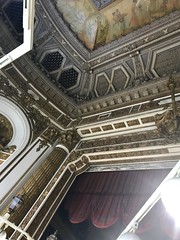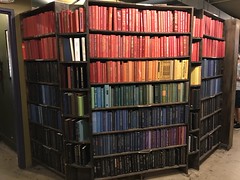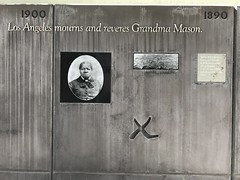 With the 2019 Masa Madness Tortilla Tournament down to its Suave Sixteen, I was reminded that I had yet to taste the winner of last year’s tournament, the legendary flour tortillas of Sonoratown. So this morning I headed to DTLA to rectify that. Arriving at 11:05am, I found there was already a line out the door and down the street, but it was a beautiful morning and the delicious aroma from the grill wafted out onto the street to give those of us in line a hint of tastes to come. The reward came on a plate with a taco de costilla (grilled slices of beef rib), a chorizo quesadilla, and a small bean and cheese burrito. I appreciated that the items are modestly sized, enabling me to sample three different expressions of their flour tortillas without being too much of a pig. Yes, flour tortillas are what it’s all about here, in the style of Sonora (northern Mexico), pressed thin, supple, and made extra delicious with generous brown stripes from the grill. An excellent complement to the grilled beef with a hint of mesquite smoke, and the crispy chorizo with its chile heat. This was all enjoyed with an horchata (they use coconut milk to make the rice starch creamier) and norteño music. Close your eyes and you could be in the chef’s hometown of San Luis Rio Colorado, just south of the Arizona border. Open your eyes, and see the line of people a multicolored array of Hispanic, African, Asian, Middle Eastern, and European ancestry, and you know you’re in LA.
With the 2019 Masa Madness Tortilla Tournament down to its Suave Sixteen, I was reminded that I had yet to taste the winner of last year’s tournament, the legendary flour tortillas of Sonoratown. So this morning I headed to DTLA to rectify that. Arriving at 11:05am, I found there was already a line out the door and down the street, but it was a beautiful morning and the delicious aroma from the grill wafted out onto the street to give those of us in line a hint of tastes to come. The reward came on a plate with a taco de costilla (grilled slices of beef rib), a chorizo quesadilla, and a small bean and cheese burrito. I appreciated that the items are modestly sized, enabling me to sample three different expressions of their flour tortillas without being too much of a pig. Yes, flour tortillas are what it’s all about here, in the style of Sonora (northern Mexico), pressed thin, supple, and made extra delicious with generous brown stripes from the grill. An excellent complement to the grilled beef with a hint of mesquite smoke, and the crispy chorizo with its chile heat. This was all enjoyed with an horchata (they use coconut milk to make the rice starch creamier) and norteño music. Close your eyes and you could be in the chef’s hometown of San Luis Rio Colorado, just south of the Arizona border. Open your eyes, and see the line of people a multicolored array of Hispanic, African, Asian, Middle Eastern, and European ancestry, and you know you’re in LA. After brunch, I explored a few DTLA sites I’d heard about. If you’re walking along 7th St between Broadway and Hill, there’s a mid-block service alley that at some point got transformed into a kitschy little faux European street called St. Vincent Court. The alley is paved in brick, and it is lined with brightly painted shopfronts with sidewalk tables and chairs. It’s as if you stepped through a portal from DTLA to Solvang, but less specific about which European country, with bits of Italian, French, German all quaintly jumbled. Behind the cute storefronts lie a couple of delis, a half-dozen kebab places (I’m guessing that the clientele from the surrounding jewelry markets must be heavily middle-Eastern), a pizzeria, and Café Bonjour (with its hospitable Asian proprietor), where I took an espresso and enjoyed watching the life on this quirky little street.
After brunch, I explored a few DTLA sites I’d heard about. If you’re walking along 7th St between Broadway and Hill, there’s a mid-block service alley that at some point got transformed into a kitschy little faux European street called St. Vincent Court. The alley is paved in brick, and it is lined with brightly painted shopfronts with sidewalk tables and chairs. It’s as if you stepped through a portal from DTLA to Solvang, but less specific about which European country, with bits of Italian, French, German all quaintly jumbled. Behind the cute storefronts lie a couple of delis, a half-dozen kebab places (I’m guessing that the clientele from the surrounding jewelry markets must be heavily middle-Eastern), a pizzeria, and Café Bonjour (with its hospitable Asian proprietor), where I took an espresso and enjoyed watching the life on this quirky little street. I wandered up to Broadway, and took a peek at the old Warner Brothers Theater. Broadway is full of the remains of once-grand movie houses, and you can see remnants of the marquees and the terrazzo in the sidewalk. What used to be the Warner Brothers Theater is now the Theater Jewelry Exchange, a marketplace of jewelry shops and stalls. But walk into the stalls and look up, and you can see the ornate ceiling of the classic movie palace. Here and there you can spot brass fixtures and chandeliers. The big red curtain is even still there. It’s an odd juxtaposition with its present use, stalls set up where the audience would have sat 80 years ago.
I wandered up to Broadway, and took a peek at the old Warner Brothers Theater. Broadway is full of the remains of once-grand movie houses, and you can see remnants of the marquees and the terrazzo in the sidewalk. What used to be the Warner Brothers Theater is now the Theater Jewelry Exchange, a marketplace of jewelry shops and stalls. But walk into the stalls and look up, and you can see the ornate ceiling of the classic movie palace. Here and there you can spot brass fixtures and chandeliers. The big red curtain is even still there. It’s an odd juxtaposition with its present use, stalls set up where the audience would have sat 80 years ago. At 5th and Spring, I came to The Last Bookstore, an impressive independent bookstore occupying a good quarter of a downtown block on two floors, filled with new and used books, the shelves peppered with comfy chairs. (Admittedly, it’s not Powell’s, but it’s pretty good.) It has some fun curiosities as well: a tunnel made of old books stacked into a long arch, an old bank vault housing the horror section, and several shelves of “decorative books”, organized by color and size.
At 5th and Spring, I came to The Last Bookstore, an impressive independent bookstore occupying a good quarter of a downtown block on two floors, filled with new and used books, the shelves peppered with comfy chairs. (Admittedly, it’s not Powell’s, but it’s pretty good.) It has some fun curiosities as well: a tunnel made of old books stacked into a long arch, an old bank vault housing the horror section, and several shelves of “decorative books”, organized by color and size. In the block between Spring and Broadway and 3rd and 4th, I found an open space amidst the buildings with some plantings, a fountain, some nice places to sit, and a long granite wall memorializing a rather remarkable woman named Biddy Mason. She was born a slave in Mississippi in 1818, followed with her owner’s family on a Mormon migration to Utah and then California, where she petitioned for and won her freedom. She worked in Los Angeles as a nurse and midwife, delivering hundreds of babies. She saved diligently and invested in real estate near downtown Los Angeles (including the land where this small park is), making a small fortune, and becoming a major philanthropist as well as a co-founder of the First African Methodist Episcopal Church of Los Angeles and the first elementary school for black children in Los Angeles. The granite wall has a timeline of the 1800s with events in Biddy Mason’s life aligned with events in the growth of this part of Los Angeles. What an impressive woman!
In the block between Spring and Broadway and 3rd and 4th, I found an open space amidst the buildings with some plantings, a fountain, some nice places to sit, and a long granite wall memorializing a rather remarkable woman named Biddy Mason. She was born a slave in Mississippi in 1818, followed with her owner’s family on a Mormon migration to Utah and then California, where she petitioned for and won her freedom. She worked in Los Angeles as a nurse and midwife, delivering hundreds of babies. She saved diligently and invested in real estate near downtown Los Angeles (including the land where this small park is), making a small fortune, and becoming a major philanthropist as well as a co-founder of the First African Methodist Episcopal Church of Los Angeles and the first elementary school for black children in Los Angeles. The granite wall has a timeline of the 1800s with events in Biddy Mason’s life aligned with events in the growth of this part of Los Angeles. What an impressive woman!

No comments:
Post a Comment